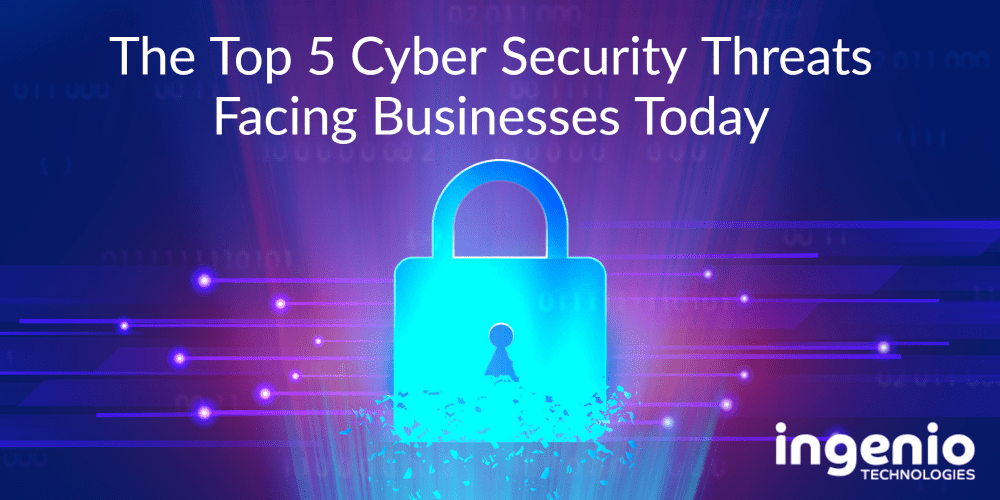Cyber threats are becoming increasingly sophisticated and frequent in today’s digital age. As a result, businesses face a range of cyber security threats that can result in data breaches, financial loss, and reputational damage.
What is a Cyber Threat?
A cyber threat is any malicious act or activity that targets computer networks, systems, or devices, with the intent to compromise, damage, or disrupt their normal functioning. Cyber threats can come from a variety of sources, including individuals, organised groups, or even nation-states, and they can take many different forms.
Some common examples of cyber threats include malware, phishing attacks, ransomware, denial-of-service (DoS) attacks, and insider threats. Malware is malicious software designed to infiltrate a computer system and damage or steal data. Phishing attacks are a type of social engineering attack where attackers use fraudulent emails, websites, or other online communication methods to trick individuals into revealing sensitive information. Ransomware is a type of malware that encrypts a victim’s files and demands payment in exchange for the decryption key. Denial-of-service (DoS) attacks are designed to overwhelm a network or website with traffic, rendering it unusable. Insider threats are threats that come from within an organisation, such as an employee stealing sensitive data.
Cyber threats are a serious concern for individuals, businesses, and governments alike. They can result in financial loss, reputational damage, and even national security threats. It is important to implement strong cybersecurity measures, such as using strong passwords, keeping software up-to-date, and regularly backing up data to protect against cyber threats. It is also important to remain vigilant and stay informed about the latest cyber threats and trends.
In this blog, we will discuss the top 5 cyber security threats facing businesses today and provide some tips on how to mitigate these risks.
Phishing Attacks:
Phishing attacks remain the most common type of cyber-attack. In a phishing attack, hackers send fake emails that appear to be from a legitimate source, such as a bank or a colleague. These emails often include a link or attachment that, when clicked, downloads malware onto the victim’s computer or prompts the victim to enter sensitive information. Businesses should educate their employees to prevent phishing attacks by recognising and reporting suspicious emails, implementing email filters to block suspicious messages, and using multi-factor authentication to verify user identities.
Ransomware Attacks:
Ransomware attacks have become increasingly common in recent years. In a ransomware attack, hackers use malware to encrypt a victim’s files and demand payment in exchange for the decryption key. To protect against ransomware attacks, businesses should implement regular data backups, install antivirus software and firewalls, and limit employee access to sensitive information.
Insider Threats:
Insider threats are a growing concern for businesses. These threats can come from current or former employees, contractors, or business partners. Insider threats can include theft of intellectual property, sabotage, or unauthorised access to sensitive data. To mitigate insider threats, businesses should implement strict access controls, conduct regular security training for employees, and monitor user activity on their networks.
Advanced Persistent Threats (APTs):
APTs are a sophisticated type of cyber-attack that can go undetected for months or even years. In an APT attack, hackers use a range of tactics, such as social engineering and malware, to gain access to a victim’s network and steal sensitive data. To protect against APTs, businesses should implement network segmentation, regularly monitor their networks for suspicious activity, and use intrusion detection and prevention systems.
Internet of Things (IoT) Attacks:
As businesses increasingly use IoT devices, such as smart thermostats and security cameras, these devices become potential targets for cyber attackers. Hackers can use IoT devices to gain access to a business’s network or steal sensitive information. To mitigate IoT attacks, businesses should use secure IoT devices, change default passwords on IoT devices, and segment IoT devices from their main networks.
How Can Businesses Prevent Cyber-attacks?
Businesses can prevent cyber threats by implementing a comprehensive cybersecurity strategy that includes the following measures:
Conduct Regular Security Audits
Regular security audits can help identify a company’s systems, networks, and processes vulnerabilities. Businesses can take proactive steps to mitigate the risks by identifying potential weaknesses.
Train Employees
Educating employees about cyber threats and how to prevent them is essential for any business. Employees should be trained to recognise phishing scams, avoid downloading suspicious attachments or clicking on links from unknown sources, and understand the importance of using strong passwords.
Use Strong Passwords and Authentication
Passwords should be strong, unique, and changed frequently. Multi-factor authentication should also be used to verify user identities, making it more difficult for cyber attackers to gain unauthorised access.
Keep Software and Systems Up-to-Date
Cyber attackers often exploit vulnerabilities in outdated software and systems. By keeping software and systems up-to-date, businesses can reduce the risk of successful cyber-attacks.
Implement Firewalls and Anti-Malware Software: Firewalls can help protect a business’s network by blocking unauthorised access. Anti-malware software can help prevent and detect malware, viruses, and other malicious software.
Limit Access to Sensitive Data: Not all employees need access to sensitive data. However, by limiting access to sensitive data, businesses can reduce the risk of insider threats and other cyber-attacks.
Regularly Backup Data
Regularly backing up data can help ensure that businesses can quickly recover from a cyber-attack. Data backups should be stored offsite and encrypted for added security.
Establish an Incident Response Plan: Businesses should have a plan in place to respond to cyber-attacks. This plan should include steps to contain the attack, notify affected parties, and restore normal operations.
In conclusion, cyber security threats are an ongoing challenge for businesses. However, by understanding the types of cyber threats they face and implementing effective security measures, businesses can better protect themselves from cyber-attacks and reduce their risk of financial loss and reputational damage.
If you would like to discover more about cyber security for your business, contact our experts today on 01273 806211 or email [email protected].


